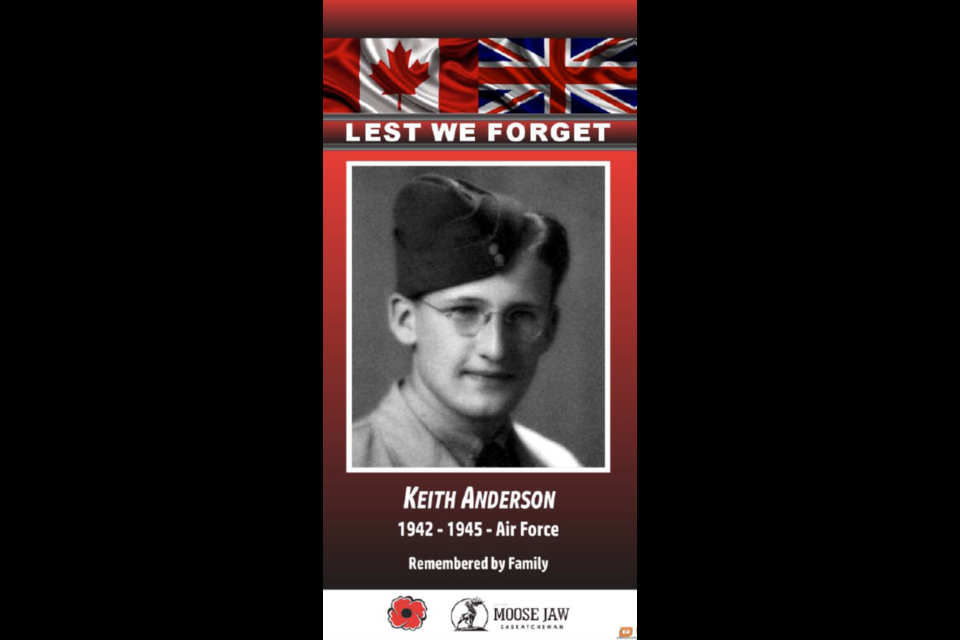Below are the biographies of three men and the Saskatchewan Dragoons who appear on the banners. The information comes from the City of Moose Jaw website.
This is part 1 of 7.
Keith Anderson
Keith Anderson was born in 1923 in Briercrest. He joined the Royal Canadian Air Force (RCAF) in October 1942 in Moose Jaw and trained as a Wireless Electrical mechanic (W.E.M.) for six months before moving to Montreal for basic training.
After 10 months there, he was sent to Jarvis, Ont., for bombing and gunnery school, where he serviced Ansons and Lysanders. He later volunteered for overseas duties in 1944 and was posted to England with 426 Bomber Squadron, working on Halifax and Lancaster bombers.
After D-Day, he transferred to 409 Nighthawk Squadron “to see more action,” where he worked on Mosquito fighter/bombers. As the war progressed, the squadron moved across Europe, through Belgium and Holland and into Germany when the war ended.
He returned to England, then to Halifax, and then Regina, and was discharged in October 1945.
Mansell Clifton Biden
Although most families were not involved in their loved one’s war experiences, they did live with the effects. I (Gwelda Hales) appreciate veterans’ abilities to lead positive, happy lives after the war, but I understand that for some, the struggle was great.
I thank you for this opportunity to understand through my research and my thoughts on my dad, that era and the effects it had on my father’s generation.
He was a member of the Great Generation and as he lived through the First World War, the 1918 Pandemic, the Roaring Twenties, the Dirty Thirties, the Second World War, the Cold War, the hippie generation, inflation, deflation, terrorism at home and abroad plus more and still led happy lives … I feel they deserve this title.
My heart goes out to all Canadian Veterans from the past and the present. Bravo to you all.
William Harry Fedyk
William (Bill) Fedyk was born in Moose Jaw on Oct. 17, 1921. The family moved to a farm near Ardill, Sask., in 1922, where Bill went to Sully School and Lake of the Rivers School until completing Grade 8.
In 1937, he left the farm to look for work. Bill enlisted on Feb. 24, 1942, in Moose Jaw in The King’s Own Rifles of Canada and transferred to the 28th Canadian Armoured Regiment (British Columbia Regiment) of the Royal Canadian Armoured Corps.
Bill completed his basic training on April 30, 1942, and joined the BCR in Debert, N.S., on May 30, 1942. He completed his basic armoured training on June 21, 1942. Bill shipped out from Debert to England on Aug. 21, 1942, and arrived in the U.K. on Sept. 1, 1942. He served as a loader operator in a Sherman tank crew for the duration of the war.
Bill first saw action in August 1944 in France during Operation Tractable. He served with the 29th Canadian Armoured Regiment in the pursuit of German forces through France and Belgium, through the winter of 1944-45 in the Netherlands and into Germany in the spring of 1945 until the end of the war.
Then, as part of the Canadian Army Occupation Force, he remained on duty in Germany and the Netherlands until he returned to Canada and was discharged in January 1946.
Following the war, Bill took up farming in the Ardill area until retiring to Moose Jaw in 1998. Bill died in 2011 at the age of 89.
Saskatchewan Dragoons
This banner acknowledges and honours the service of the hundreds of Saskatchewan citizens who chose to serve Canada since its inception. Specifically, this banner honours those who wore the cap badge of The Saskatchewan Dragoons, past and present.
This banner spans all expeditionary operations, domestic operations, conflicts, peace support operations, and training exercises. This banner honours the service of all those members who may not have achieved individual accolades or acknowledgement but have contributed to the success of the unit.
Working in crews, teamwork is a core value of cavalry units, and as such, the sacrifice of these soldiers exemplifies prioritizing the team over the individual. These soldiers shared in the challenge, fear and experiences of those who earned acknowledgement and honours. To them, we say, “FIRST IN – LAST OUT.”




